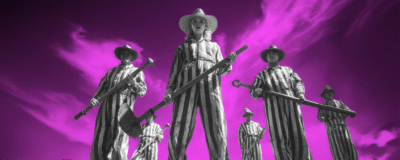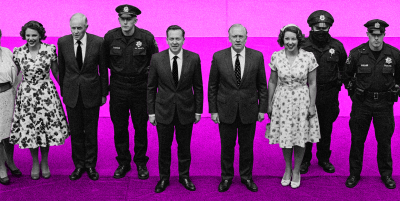by Sarah Smith, ProPublica
Kurt Thigpen clenched his hands around the edge of the table because if he couldn’t feel the sharp edges digging into his palms, he would have to think about how hard his heart was beating. He was grateful that his mask hid his expression. He hoped that no one could see him sweat.
A woman approached the lectern in the center aisle, a thick American flag scarf looped around her neck.
“Do you realize the mask, the CDC said it’s only 2% effective?” she demanded. “You’re failing our children, you’re failing our country, you’re failing our students’ future ….”
Thigpen fixed his eyes on a spot in the back of the blue-and-green auditorium. He let the person speaking at the lectern fade. It will be over soon, he told himself.
A dark-haired woman in a red vest removed her face shield as she moved to take her turn at the mic. As she began to speak, the school board employee responsible for queuing up public commenters interrupted: “Ma’am, I’m gonna have to ask you to please keep your shield on —”
“No, you’re not the boss of me, you work for us, I can’t breathe with it on —”
“Ma’am —”
“Don’t you dare cut my microphone —”
The crowd cheered. Thigpen focused on his breathing.
It will end soon, he told himself. It must. His sweat turned cold under his suit.
“The science isn’t there, take the kids outta the masks and let’s move on.”
It was March 2021, Thigpen’s second month as a school board trustee in Washoe County, Nevada. He had planned his campaign around local issues like improving the district’s diversity and equity policies and fixing an intersection where 20 students had been injured in traffic.
Public comment periods at school board meetings felt endless. Parents’ angers — over masking, over politics, over the “LGBTQ agenda” — fed off each other.
“I came here to speak about your fascist propaganda and ideology …”
He concentrated on making it to the next break period. His thoughts had begun to turn toxic. Why am I not good enough? Why am I the one struggling? They would turn darker. I don’t want to be here anymore. If something happened to me today, that would be fine.
“We will work tirelessly to remove you if you don’t focus on what’s important ….”
When the eight-hour meeting finally ended, he would drive home and pull off the suit and rip off his shirt. He would only take care with his rainbow tie, resting it gently in the closet. It still hangs there today. He would close the door, lay down on his bed, and let himself cry.
The stories of cruel, seemingly irrational and sometimes-violent conflicts over coronavirus regulations have become lingering symptoms of the pandemic as it drags through its second year. Two men on a Mesa-to-Provo flight got into a cross-aisle fight after one refused to wear a mask. A Tennessee teenager asking his school board to impose a mask mandate in honor of his grandmother who died of COVID-19 got jeered by the crowd. A California parent angered by the requirement that his child wear a mask allegedly beat up a teacher so badly that the teacher had to go to the emergency room. An Arizona father showed up to an elementary school with zip ties, allegedly intending to make a “citizen’s arrest” over COVID-19 rules. A Missouri medical center has distributed panic buttons to about 400 employees after an increase in assaults on health care workers by people frustrated over coronavirus-induced visitation restrictions and long wait times.
Many of the altercations have begun over masking because, unlike your vaccination status, a mask is right there on your face. Depending on your point of view, the mask can symbolize an erosion of personal freedoms or a willingness to protect others, a society that accepts tyranny or one that embraces science. A person’s reaction to a mask — or the absence of one — can be driven by an entire network of beliefs and emotions that have little to do with the face covering itself.
“What the hell is happening?” said Rachel Patterson, who owns a hair salon in Huntsville, Alabama, and who has been screamed at, cussed out and walked out on for asking clients to don a mask. “Like, I feel like we are living on another planet. Like I don’t — I don’t recognize anyone anymore.”
On Julie Simanksi’s first day of teaching for the fall 2021 semester, she tried to get her students to wear masks using the only method she was allowed: an emotional appeal. Simanski teaches at Des Moines Area Community College in Iowa. By state university policy, she can’t instruct her students to wear masks. Almost none did.
Simanksi told her students about her 20-year-old daughter, Olivia, who has a neuromuscular condition and requires 24-hour care. She didn’t know how Olivia’s body would cope with the virus. She was scared.
That night she sent an all-class email. She attached a picture of Olivia, smiling to her gums in blue sunglasses.
“I cannot mandate you to wear a mask in my class,” she wrote. “However, for the sake of my daughter and potentially others, I will make a continual plea to wear one.”
Simanksi brought a box of paper masks and put them in the back of the room. Some students took them. In each of her two sections, she has a group of four or five students who will not put one on.
“I’m surprised and I’m disappointed and a little bit angry that they just didn’t have the compassion to wear a mask for 55 minutes,” she said.
People’s pandemic views aren’t just preferences. They’ve evolved to fundamental beliefs. And when that happens, social psychologists say, people are more likely to accept incivility to achieve what they want.
“When people feel that their attitudes reflect strong moral convictions, that gives them permission to dehumanize those who oppose them,” said Linda Skitka, a psychology professor at the University of Illinois at Chicago who’s researching ideological divides. “And it doesn’t take a lot for the shift into perceptions of good and evil. So if the other side is basically evil, it’s not a far stretch to say it’s OK to yell at them.”
Courtney, a 29-year-old office worker living in Virginia who has asked that her last name not be shared for fear that she might lose her job if she’s identified, sat up on a medical bed surrounded by portraits of expectant mothers and their babies. In one, a brown-haired woman smiled at her 32-week mark, hands cupping her round belly. In another, the woman’s 6-day-old baby lay swaddled in a blue-and-white quilt, eyes closed. Courtney had just listened to her unborn child’s heartbeat. It was Aug. 17, two months out from her due date, and she had never before gotten so far along in a pregnancy without a miscarriage.
Courtney said her doctor went through the standard questions about her physical condition. Then the doctor asked if Courtney was working from home. No, she said. She had to go in twice a week.
Courtney looked at the pictures of the happy mothers. She’d undergone fertility treatment and had two miscarriages in less than a year. Both times, she’d asked herself: Was it my fault?
She knew that, even though she’d been fully vaccinated since May, a severe breakthrough infection could mean a ventilator for her and premature birth or death for her baby. She walked out of the office with a doctor’s note: Either everyone had to wear a mask around her, or she needed to work from home.
She saved a copy of the note on her phone and brought it with her the next time she went to the office. She recalls that as she sat at her desk, a colleague she considered a friend walked through her open door and sat down across from her. The colleague had just returned from a weeklong vacation and hoped Courtney could catch her up on what she’d missed.
The woman wasn’t wearing a mask.
“I actually have this note,” Courtney recalls saying. She pulled it up on her phone and held it out. “Do you mind wearing a mask?”
Her colleague didn’t look at the phone. She didn’t need to mask, the woman said. She had antibodies.
Courtney tried again. She told her colleague she was worried about what the virus could do to her baby. Even if there was no damage, she said, they might have to take the baby after birth to isolate her.
Courtney said that her colleague looked at her across the desk and said: “I’m not worried about it.”
She sat across from Courtney unmasked for the next 30 minutes.
Two weeks later, Courtney’s doctor wrote her another, sterner note: “It is my professional opinion that due to the lack of support for CDC recommended mask wearing indoors, please allow Courtney to work from home for the remainder of her pregnancy.”
Courtney forwarded it to her boss. He replied that he would remind the colleague who had sat in her office unmasked to follow the policy. But she still had to come in to work. They needed staff consistency.
She is due within the month.
If it looks like we’ve forgotten each other’s humanity, it’s because we’ve evolved to do so.
Humans are tribal creatures, and our responses to the pandemic have been tribalized almost since the beginning: A Pew Research poll from June 2020 found support for masking divided along partisan lines. Almost a year after the Pew poll, Fox News host Tucker Carlson urged his supporters toconfront people wearing masks.
Because the mask has become so polarizing, the extreme reactions aren’t really about being asked to wear one for an hour. It’s about communicating what side you’re on.
David Chester, a psychology professor at Virginia Commonwealth University who studies aggression, puts it this way: If you see members of the opposing group as human like you, you’ve failed as a tribalist.
“It really makes adaptive sense to treat out-group members not like people, because then it’s much easier to hurt them and to act against them,” he said. “One central piece of intergroup conflict is a switch in viewing your enemies from full-blown humans to dehumanized entities that you do not ascribe all the things that you typically ascribe to a person. That makes conflict so much easier.”
Seeing someone else wear a mask in a grocery store becomes what Chester calls “a threatening proposition from an out-group member.” It triggers anger. And giving in to anger can feel good — especially after months of frustration.
In a viral incident from June 2020, a woman who has cancer was shopping in a Florida Pier 1 when she had a confrontation with another shopper, later identified as Debra Jo Hunter. The incident culminated in Hunter, maskless,coughing in the woman’s face. In a virtual sentencing hearing nine months later, as Jacksonville’s First Coast News reported, Hunter submitted 23 pages of threats that she and her family had received. Hog from hell. I hope your whole family gets COVID and suffers immensely, then dies. Kill yourself.
Hunter’s husband testified on her behalf. It had been a hard couple months leading up to the incident, he said. They’d had a house fire and lost most of their possessions. A family member had been in a boating accident.
No one from the family responded to requests for comment.
“It was like air being inflated into a balloon, and it finally got to the point where she couldn’t handle any more air,” Hunter’s husband testified. “And then she finally rubbed up against something and just popped.”
In a treatise on tempering strong reactions, a prominent intellectual wrote: “I thought the first step was to free a man from his passions.”
The paper was written sometime around the turn of the third century. The author was philosopher-slash-medical writer Claudius Galenus, known today as Galen.
Two millennia later, the fundamental idea holds true. It’s one of the main tools in modern-day cognitive behavioral therapy: Learn how to pull yourself back from getting swept away by strong feelings, and then evaluate the situation with your rational side.
“There’s a lot of research that says that if people think about injustice from a first-person perspective, they’re more likely to respond aggressively,” said Tracy Vaillancourt, a professor at the University of Ottawa specializing in children’s mental health and violence prevention. “If they think about injustice from a third-person perspective, they’re less likely to be aggressive. And it’s because, in a sense, now they pulled back and are able to take the perspective of both parties that are involved.”
On a societal scale, one of the fastest ways for two deeply entrenched, opposing groups to start seeing each other as fellow humans again is to give them something bigger to fight against together. It’s an “Independence Day” sort of scenario, Chester, the Virginia Commonwealth University professor, said: If aliens invaded, countries who hate each other in normal times would suddenly work together against an external threat.
But the external threat with the potential to unite a deeply polarized country, he said, should have been the pandemic. And it didn’t happen.
“I think fundamentally, it’s because we have different perceptions of this pandemic,” he said. “It’s really hard now that it’s so entrenched, that masks are viewed as this group symbol. It’s really hard to get people out of that.”
It’s possible that signals from authority figures — at least the ones you already trust — could sway individual behavior, Chester said. Then again, former President Donald Trump got booed at an August rally in Alabama after suggesting that his followers get vaccinated.
When Skitka, with the University of Illinois at Chicago, saw Trump get booed, she thought it might be too late for even political leaders to temper their constituents’ passions. “We’re still trying to figure out what will work,” she said.
Kurt Thigpen resigned from the Washoe County School District on May 24, citing medical reasons. Later, he wrote an op-ed explaining what he really meant. The anxiety and the panic that had been triggered by the school board meetings had mutated into passive suicidal ideation. Even when the board transitioned to virtual meetings, he could barely get out of bed and make himself presentable for Zoom. He wished he could stop existing. No job was worth that.
“I thought I had things handled,” he wrote, “but my coping skills were no match for the events of the last seven months.”
He had sought therapy and worked with a psychiatrist to find medication. He got diagnosed with ADHD. He learned new coping mechanisms.
The initial reaction was positive. People were angry on his behalf. They wished him well. They thanked him for his openness.
And then the op-ed was mentioned in anAssociated Press article on toxic school board meetings around the country. Thigpen had no idea until a friend on the city council texted him. His original op-ed got reshared on Facebook. The commenters rushed in.
“What a whiney person,” someone wrote.
“Where do these woke zombies come from?”
“I have a lot to say to this young fragile individual.”
“Perfect example of a PACB= Professional Adult Cry Baby”
“You have no idea how badly I wanted to stop reading that article, but he is such a trainwreck of an individual I couldn’t stop,” one woman posted. She added: “You know, upon re-reading my post, I apologize for being so cruel. Clearly this man is severely mentally disabled and belongs in an institution.”
No one, Thigpen said, has reached out to apologize.
This article appears courtesy of ProPublica. The original story appears here.
ProPublica is a Pulitzer Prize-winning investigative newsroom.
Sign up for The Big Story newsletter to receive stories like this one in your inbox. Series: Coronavirus The U.S. Response to COVID-19




